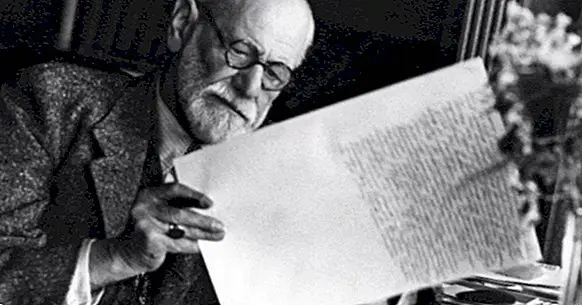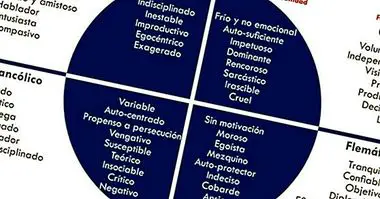The theory of the personality of Sigmund Freud
Sigmund Freud (1856-1939), the founder of psychoanalysis, developed several models to explain human personality throughout his literary career.
In this article we will analyze the 5 theories of Freud on the personality : the topographic, the dynamic, the economic, the genetic and the structural.
- Maybe you're interested: "The 31 best Psychology books you can not miss"
The 5 theories of the personality of Sigmund Freud
Although there are certain contradictions between the personality models created by Freud, in general can be thought of as complementary theories or as updates and developments of several fundamental concepts, for example the drives or defense mechanisms. Let's see what each one of these theories consists of.
1. Topographic model
Freud developed the topographic model during the first stage of his career. It was originally described in one of his key works: "The interpretation of dreams", published in the year 1900. This theory about personality is also known as "First Topical".
The topographic model divides the mind into three "regions": the unconscious, the preconscious and the conscious . In each of these places, which must be understood in a symbolic way, we would find different psychological contents and processes.
The unconscious is the deepest level of the mind. In it are hidden thoughts, impulses, memories and fantasies that are very difficult to access from consciousness. This part of the mind is directed by the pleasure principle and by the primary processes (condensation and displacement), and the psychic energy circulates freely.
The preconscious mind acts as a point of union between the other two sections . It is made up of memory traces in verbal format; In this case, it is possible to know the contents of consciousness through the focus of attention.
Finally, consciousness is understood as a system with an intermediary role between the deepest regions of the psyche and the outside world. Cognition, motor skills and interaction with the environment depend on the conscious mind, which is governed by the reality principle instead of the pleasure, in the same way as the preconscious.
- Related article: "Sigmund Freud: life and work of the famous psychoanalyst"
2. Dynamic model
The "dynamic" concept refers to a conflict between two forces that occurs in the mind: impulses ("instinctive" forces), seeking gratification, and defenses, which seek to inhibit to the previous ones. From the result of this interaction arise psychological processes, which suppose a more or less satisfactory or adaptive resolution of conflicts.
In this model, Freud conceives the psychopathological symptoms as formations of commitment that allow a partial gratification of the impulses while causing discomfort, acting as a punishment against the behavior of the person. In this way mental health would depend to a large extent on the quality of the defenses and of self-cancellations.
- Maybe you're interested: "The main theories of personality"
3. Economic model
The fundamental concept of the economic model of personality is that of "drive", which can be defined as an impulse that favors the person to seek a certain goal. These impulses have a biological origin (in particular they are related to body tension) and their objective is the suppression of unpleasant physiological states.
Within this model we actually find three different theories, developed between 1914 and 1920 in the books "Introduction to narcissism" and "Beyond the pleasure principle". Initially Freud distinguished between the sexual drive or reproduction , which leads to the survival of the species, and self-preservation, focused on the individual's own.
Later, Freud added to this theory the distinction between object impulses, directed to external objects, and those of a narcissistic type, which focus on oneself. Finally proposed the dichotomy between the drive of life, which would include the previous two, and the death drive, criticized harshly by many of the followers of this author.
- Maybe you're interested: "We raffled 5 copies of the book" Psychologically Speaking "!"
4. Genetic model
The Freudian theory about the most well-known personality is the genetic model, in which the five phases of psychosexual development are described. According to this theory, human behavior is governed to a large extent by the search for gratification (or discharge of tension) in relation to the erogenous zones of the body, whose importance depends on the age.
During the first year of life the oral phase takes place, in which the behavior is centered in the mouth; thus, babies tend to bite and suck objects to investigate and get pleasure. In the second year, the main erogenous zone is the year, so that children of this age are very focused on excretion; for this Freud speaks of "anal phase".
The next stage is the phallic phase, which occurs between 3 and 5 years; during this period the famous Oedipus and castration complexes are produced. Between 6 years and puberty the libido is repressed and learning and cognitive development are prioritized (latency phase); Finally, with adolescence comes the genital phase, which indicates sexual maturity .
The psychopathology, more specifically the neurosis, is understood as the result of the frustration of the satisfaction of the characteristic needs of these periods of development, or of the total or partial psychological fixation in one of them due to an excess of gratification during the critical stage.
- Related article: "The 5 stages of psychosexual development of Sigmund Freud"
5. Structural model
Freud's personality theory was proposed in 1923 in the book The I and the It. Like the genetic model, the structural model is particularly known; in this case the separation of the mind in three instances that develop throughout childhood: the id, the ego and the superego . Conflicts between these would give rise to psychopathological symptoms.
The most basic part of the mind is the id, composed of unconscious representations of the drives related to sexuality and aggression, as well as mnemic traces of the gratification experiences of these impulses.
The Self is conceived as a development of the It . This structure has a regulatory role in psychological life: it evaluates the ways of satisfying impulses taking into account the demands of the environment, it works with both unconscious and conscious contents, and it is in this part of the mind where the defense mechanisms are exercised.
Finally, the superego acts as a moral conscience, censoring certain mental contents, as supervisor of the rest of instances and as a model of behavior (that is, it supposes a kind of "ideal ideal"). This structure is formed through the internalization of social norms , in which the Oedipus complex plays an essential role.
- Related article: "The id, the self and the superego, according to Sigmund Freud"



















